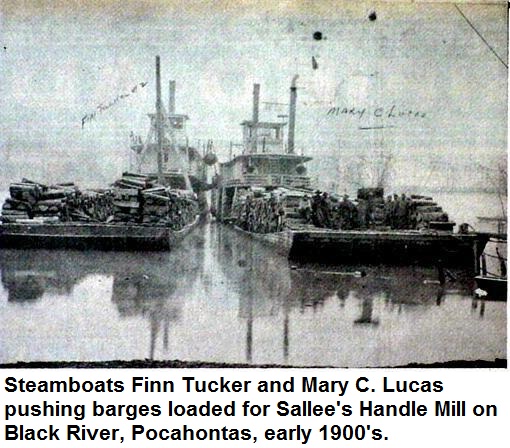4H Club Visits Fabrics and Quilts
The 4H Club visited Fabrics and Quilts in Reyno, Arkansas.
The 4H Club visited Fabrics and Quilts in Reyno, Arkansas.
(Above, steamboats docked at the Port of Pocahontas, 1890’s.)
The historic Port of Pocahontas, Overlook Park today, was a busy place between 1810 and the early 1900’s, when the railroad replaced the steamboats. It was a primary reason for the City being built here. Thanks to the water flow provided by the Fourche, Current, and Black Rivers merging just upstream from the port, Pocahontas is the northernmost point in Arkansas for year around river navigation. The Port served a large hinterland to our east, west and north. In the absence of decent roads, most goods in and out of the area came by river—flatboats and keelboats in the early part of the 1800’s, and steamboats after 1828.
 From 1840 to 1851, the Port of Pocahontas recorded more freight in and out than any other port in Arkansas.
From 1840 to 1851, the Port of Pocahontas recorded more freight in and out than any other port in Arkansas.
The Port area was a fairly exciting place, with passengers and river men arriving and departing, saloons, bawdy houses, fights, and so forth were located in that area.
River traffic after the Civil War helped rebuild the town (which was burned by the “Yankees”) and the devastated area that was Randolph County.
Recent historic research has revealed that Randolph County may have the dubious distinction as being the location where African-American slavery began in Arkansas. Agriculture above the subsistence level in Arkansas began not in the delta lands to our east but rather in the upland river and creek bottoms of Randolph County. These properties contained very rich soil, were well drained, and were also well watered.
When Fielding Stubblefield established his farm along both sides of the Eleven Point River from what’s now Dalton to the Missouri line in 1803, he wrote in his journal that the top soil in the Eleven Point Valley was six feet deep.

Rice House, Dalton Arkansas
When early settlers, such as the Looneys, Rices, and Stubblefields arrived here in the first years of the 19th Century, they brought African-American slaves with them from Tennessee.
These slaves worked in agriculture, but they were also the artisans and craftsmen who built the structures such as the William Looney Tavern and the Rice House as well as serving as blacksmiths, carpenters, and in other skilled trades.
rctourism@suddenlinkmail.com
